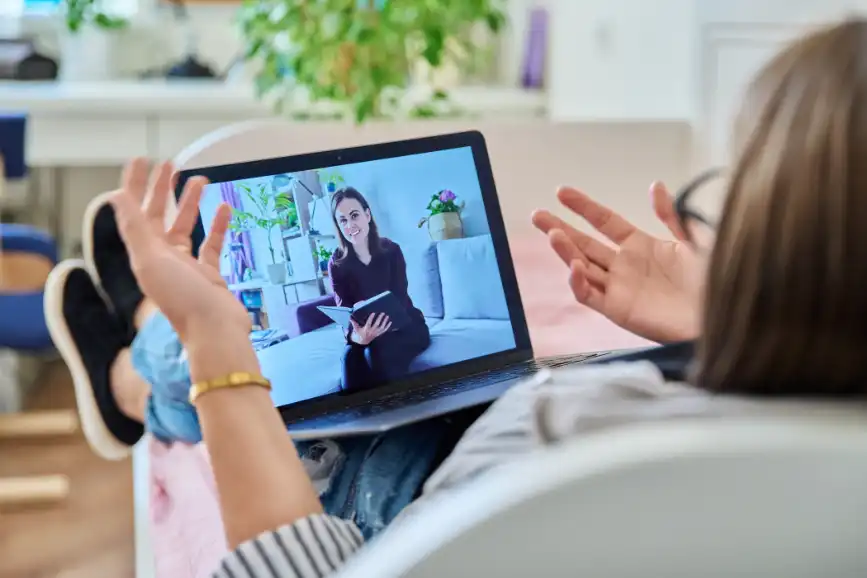What is teletherapy?
Teletherapy, also known as online therapy or e-therapy, works just like in-person therapy, but is conducted remotely, via phone or video.
How does teletherapy work?
Teletherapy sessions are conducted by phone, video, or on a designated telehealth platform. There are also teletherapy apps offering remote access to therapy sessions on your smartphone. Your provider will help walk you through how to access your teletherapy sessions. Then, your sessions will happen just like in-person therapy: your therapist will talk with you and offer you guidance to help work through the mental health challenges you’re looking to overcome. Teletherapists primarily use email, mobile apps, instant messaging, text messaging, phone calls, or video conferencing to provide care to their patients.
How do therapists ensure the security and privacy of conversations during teletherapy?
Therapists who employ teletherapy as part of their practices comply with the Health Insurance Portability and Accountability Act (HIPAA). They should also ensure that the platforms they use are secure. The American Psychological Association has created guidelines for the practice of teletherapy that lay out legal, ethical, and privacy standards teletherapists should follow. There are also measures you can take to increase your privacy:
- choose a private, quiet location where no one will overhear your conversation
- don’t share sensitive information like financial account numbers or social security numbers during sessions
- wear headphones to keep your therapist’s comments from being overheard
What conditions can teletherapy help with?
Teletherapy can be used as part of the treatment for mental health conditions such as depression, anxiety, post-traumatic stress disorder, eating disorders, addiction, attention deficit hyperactive disorder, and more. Even those without diagnosed mental health conditions can benefit from teletherapy to help maintain their mental health.
What are the advantages of teletherapy?
Teletherapy offers a number of benefits:
- Teletherapy may be less expensive than private in-person care. Many states require insurance providers to cover teletherapy just like they would traditional therapy. Check with your provider to see if they offer coverage for teletherapy services.
- For those with physical illnesses or limitations or those with complicated schedules or family obligations, teletherapy can offer greater accessibility.
- Teletherapy offers greater access to mental health care to those in remote or rural areas.
- Teletherapy is more private than in-person care – rather than visiting a busy office, you can conduct your sessions in the privacy of your own home.
- Teletherapy offers greater flexibility and convenience – no travel or extended wait times required.
What are the disadvantages of teletherapy?
Teletherapy has drawbacks, just like any other form of healthcare. Since everyone has distinct preferences for care, this might vary greatly from person to person. The common drawbacks of teletherapy may include:
- the possibility of technical problems
- potential distractions from background noise, other people, or pets
- challenges with creating a personal connection
- struggles with interpreting body language cues via video rather than face to face
How can I make the most of teletherapy?
Although talking to your therapist over the phone or through video may seem strange at first, there are some ways to make it more comfortable:
- Choose a location that is private and free of distractions to help you focus.
- Use headphones to reduce background noise.
- Have a notebook and pen nearby for any information you need to write down.
- Ask for clarification on any concerns you have about the process from your therapist and what to anticipate.
How do I find a teletherapy professional?
More and more channels are emerging for teletherapy; consider the following to determine which approach is best for you and how to get started:
- Do you want to subscribe to a service with unlimited messaging or would you prefer as-needed sessions?
- Does your insurance provider cover care through the platforms you’re considering?
- Does the platform you’re looking into let you choose your therapist?
- How do you prefer to communicate with your therapist and does the platform support that?
Once you’ve determined which type of teletherapy approach is best for you, take these steps to get started:
- Ask your insurance provider for a list of teletherapists that are part of their coverage network
- Ask friends and family who use teletherapy for recommendations
- Connect with a therapist on online platforms like BetterHelp, Open Path Psychotherapy Collective, Therapy for Black Girls, Therapy for Latinx, and Talkspace.

















